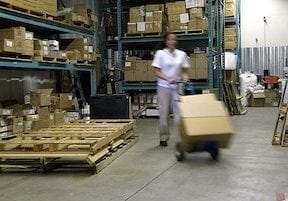Selling across international borders can provide helpful revenue to merchants. But the complexity of laws, transit times, and delivery cost can be daunting. Dr. Eugene Laney is an authority on cross-border shipping. He’s the head of international government affairs with DHL, the worldwide logistics firm.
I recently spoke with Dr. Laney on the obstacles to international selling and how small to midsize merchants can overcome them. What follows is our entire audio conversation and a transcript, edited for length and clarity.
Kerry Murdock: Should small-to-mid size merchants attempt to sell products across borders?
Eugene Laney: Yes — with giant applause around that. Ninety-five percent of all consumers live outside of the U.S. If you’re a U.S. ecommerce company, you should definitely look to sell across borders. The demand for U.S. products — textiles, apparel, electronics, footwear — in places like Australia and the E.U. is high.
In Africa, the residents between the age of 25 and 35 all have mobile phones. They’re all trying to figure out how to engage in mobile commerce. So they have direct access to products that they normally couldn’t get in their country.
You have the same situation in Southeast Asia. You have the growing youth population that wants access to a lot of products and services that are outside of their country.
Murdock: If a merchant receives an order from an unfamiliar country, how does he know if it’s worth the trouble to ship there?
Laney: When you first determine that you want to start selling overseas, you have to identify which markets would have an interest in your product. You need to know the three W’s. “Who” will buy it? “What” do I do to ship it there? And “where” do I ship it?
That kind of market analysis will help you avoid some of the dangers. You have to know exactly where your market is and then build in shipping costs that comes with it.
Murdock: How can a merchant determine where those markets are?
Laney: Start with the countries that are closest. So if you’re a U.S. ecommerce company, begin by looking at Canada and Mexico.
Canada is a developed country with a huge demand for many consumer products. Mexico is a developing country with some demand, but not high demand. That’s an opportunity to identify how your product might fit in those countries. If you do well in Mexico, then you may want to expand further into Latin America, or you may want to take a huge leap into Southeast Asia. If you do well in Canada, then that opens an opportunity to sell into Europe.
Murdock: What about different customs duties for each country? How can a merchant know what they are?
Laney: Leverage your logistics provider. Many providers, such as DHL, can supply all of the compliance materials and the understanding of what you need as far as documentation and fees to ship a good from one country to another.
A lot of government authorities, particularly the U.S. and the U.K. do a great job, too, in listing products that need a license, a fee, and whether they are denied or restricted.
The U.S. Department of Commerce has a Commercial Service office in every major city. Their job is to help U.S. exporters grow their business. Whatever you’re trying to sell — toys, jeans, a new widget — you can contact your local U.S. Commercial Service office. They can help you learn about a particular market. They can also be an advocate to get your product to the right place when you’re trying to ship there.
The U.K., Canada, and most larger countries have similar services. Just search on the internet.
Murdock: How can a merchant determine if it’s worthwhile to have a second warehouse operation in another country? Does DHL provide those warehouses?
Laney: DHL has a sister company that provides warehousing for ecommerce companies as well as other companies that are interested in housing their products in a country and then shipping it out from there.
As far as an ecommerce company making that determination, that is a tough decision. One of the challenges is to determine the regulations or warehousing availability in certain countries
In choosing an overseas warehouse, think carefully about retaining control. There’s a whole list of ecommerce companies that have failed, particularly going into India. They’ve tried to sub-contract warehousing and then their customer service goes down. They can’t control their inventory because they lose the ability to be on site and to manage the movement and the flow of goods in and out of the warehouse. A lot of companies are stepping back and attaching to a larger platform, such as Amazon, Etsy, Pitney Bowes, and others.
Murdock: Does DHL have a shopping cart integration for international shipments?
Laney: We have what we call a Trade Automation Service. It provides a number of services. The landing cost calculator can estimate your taxes and duties, and import fees. It can help with product compliance. It can also help with denied party screening.
So if you’re trying to send something overseas and you’re using our Trade Automation Service, it’ll help you to understand whether that customer is on a denied party list or whether that product is on a restricted list.
Murdock: How are the tariffs or threatened tariffs imposed by the Trump administration affecting international commerce?
Laney: It’s having an enormous effect on larger companies. If they’re doing a lot of manufacturing and they need raw materials from other countries, such as China, the number of duties that they’re paying has increased.
More importantly, it’s hurting small and medium-sized businesses— including ecommerce companies. A lot of the technical products to create computers, servers, and back-office equipment are on tariff lists. Those higher costs are passed on to consumers and companies that are trying to buy new servers and new computers, as well as create new products.
Murdock: Anything else?
Laney: To succeed in exporting, you have to know your product. Is there compliance around that product? Is there licensing around that product? Is it acceptable in certain countries? Is there a demand for it?
Before you start, map your supply chain. Get an understanding of which logistics provider you want to work with. What airports will you go through? What ports will you go through? How is it going to be delivered? Who owns the information and the data from your overseas customers, such as the credit card information, the financial information, the address?
Build a good trade compliance program. You have to understand the risks around sending any product abroad.
Leverage your relationship with your government authorities. There are many free government programs for small and medium-sized business to learn how to export.




